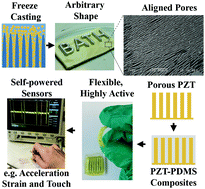当前位置:
X-MOL 学术
›
Energy Environ. Sci.
›
论文详情
Our official English website, www.x-mol.net, welcomes your
feedback! (Note: you will need to create a separate account there.)
Flexible and active self-powered pressure, shear sensors based on freeze casting ceramic–polymer composites†
Energy & Environmental Science ( IF 32.4 ) Pub Date : 2018-07-12 00:00:00 , DOI: 10.1039/c8ee01551a Mengying Xie 1 , Yan Zhang 1, 2 , Marcin J Kraśny 1 , Chris Bowen 1 , Hamideh Khanbareh 1 , Nicholas Gathercole 1
Energy & Environmental Science ( IF 32.4 ) Pub Date : 2018-07-12 00:00:00 , DOI: 10.1039/c8ee01551a Mengying Xie 1 , Yan Zhang 1, 2 , Marcin J Kraśny 1 , Chris Bowen 1 , Hamideh Khanbareh 1 , Nicholas Gathercole 1
Affiliation

|
Self-powered flexible electronics are of particular interest and important for next generation electronics due to their light weight, flexible and self-sustainable properties. Many self-powered sensors made from piezoelectric composite materials are either inflexible or possess low piezoelectricity. In this work, we demonstrate self-powered flexible and highly active pressure and shear sensors based on freeze casting ceramic–polymer structures. A lamellar lead zirconate titanate (PZT) structure is initially developed via freeze-casting and the piezoelectric composites are formed by impregnating a polydimethylsiloxane (PDMS) matrix into the aligned pore channels. The structured PZT–PDMS composites exhibited a high effective longitudinal piezoelectric coefficient (d33*) of 750 pC N−1, which is higher than that of the monolithic ceramic due to the combination of bending and flexural effects. The use of freeze casting enables the manufacture of complex and arbitrary shaped 3D piezoelectric architectures, along with the unique advantages of low-cost and ease of fabrication. A 14 × 14 mm2 PZT–PDMS pressure sensor was able to bend to a small radius of 8 mm and maintain a high d33. Furthermore, the manufactured self-powered sensors are demonstrated in a range of applications, such as acceleration, strain and touch sensors that use the d33, d31 and d15 coefficients to detect longitudinal, transverse and shear loads. This work expands on the potential applications of freeze casting and provides new opportunities for the manufacture of future electronic sensors.
中文翻译:

基于冷冻铸造陶瓷-聚合物复合材料的灵活主动自供电压力、剪切传感器†
自供电柔性电子产品因其重量轻、柔性和自我可持续的特性而对下一代电子产品特别感兴趣和重要。许多由压电复合材料制成的自供电传感器要么不灵活,要么具有低压电性。在这项工作中,我们展示了基于冷冻铸造陶瓷聚合物结构的自供电柔性和高活性压力和剪切传感器。最初通过冷冻铸造开发了层状锆钛酸铅 (PZT) 结构,并通过将聚二甲基硅氧烷 (PDMS) 基质浸渍到对齐的孔通道中来形成压电复合材料。结构化的 PZT-PDMS 复合材料表现出高有效纵向压电系数 ( d 33*) 为 750 pC N -1,由于弯曲和弯曲效应的结合,该值高于单片陶瓷。使用冷冻铸造可以制造复杂和任意形状的 3D 压电结构,并具有低成本和易于制造的独特优势。一个 14 × 14 mm 2 PZT-PDMS 压力传感器能够弯曲到 8 mm 的小半径并保持高d 33。此外,制造的自供电传感器在一系列应用中得到了展示,例如使用d 33、d 31和d 15的加速度、应变和触摸传感器系数来检测纵向、横向和剪切载荷。这项工作扩展了冷冻铸造的潜在应用,并为未来电子传感器的制造提供了新的机会。
更新日期:2018-07-12
中文翻译:

基于冷冻铸造陶瓷-聚合物复合材料的灵活主动自供电压力、剪切传感器†
自供电柔性电子产品因其重量轻、柔性和自我可持续的特性而对下一代电子产品特别感兴趣和重要。许多由压电复合材料制成的自供电传感器要么不灵活,要么具有低压电性。在这项工作中,我们展示了基于冷冻铸造陶瓷聚合物结构的自供电柔性和高活性压力和剪切传感器。最初通过冷冻铸造开发了层状锆钛酸铅 (PZT) 结构,并通过将聚二甲基硅氧烷 (PDMS) 基质浸渍到对齐的孔通道中来形成压电复合材料。结构化的 PZT-PDMS 复合材料表现出高有效纵向压电系数 ( d 33*) 为 750 pC N -1,由于弯曲和弯曲效应的结合,该值高于单片陶瓷。使用冷冻铸造可以制造复杂和任意形状的 3D 压电结构,并具有低成本和易于制造的独特优势。一个 14 × 14 mm 2 PZT-PDMS 压力传感器能够弯曲到 8 mm 的小半径并保持高d 33。此外,制造的自供电传感器在一系列应用中得到了展示,例如使用d 33、d 31和d 15的加速度、应变和触摸传感器系数来检测纵向、横向和剪切载荷。这项工作扩展了冷冻铸造的潜在应用,并为未来电子传感器的制造提供了新的机会。











































 京公网安备 11010802027423号
京公网安备 11010802027423号